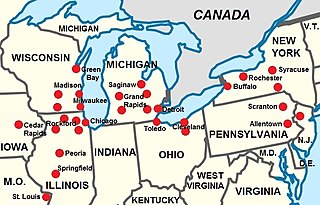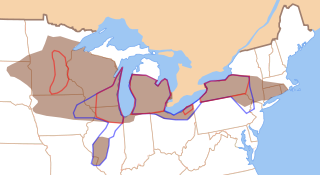American English, sometimes called United States English or U.S. English, is the set of varieties of the English language native to the United States. English is the most widely spoken language in the United States and in most circumstances is the de facto common language used in government, education and commerce. It is also the official language of most US states. Since the late 20th century, American English has become the most influential form of English worldwide.
Spoken English shows great variation across regions where it is the predominant language. The United Kingdom has a wide variety of accents, and no single "British accent" exists. This article provides an overview of the numerous identifiable variations in pronunciation. Such distinctions usually derive from the phonetic inventory of local dialects, as well as from broader differences in the Standard English of different primary-speaking populations.
General American English, known in linguistics simply as General American, is the umbrella accent of American English spoken by a majority of Americans, encompassing a continuum rather than a single unified accent. It is often perceived by Americans themselves as lacking any distinctly regional, ethnic, or socioeconomic characteristics, though Americans with high education, or from the North Midland, Western New England, and Western regions of the country are the most likely to be perceived as using General American speech. The precise definition and usefulness of the term continue to be debated, and the scholars who use it today admittedly do so as a convenient basis for comparison rather than for exactness. Other scholars prefer the term Standard American English.
Southern American English or Southern U.S. English is a regional dialect or collection of dialects of American English spoken throughout the Southern United States, though concentrated increasingly in more rural areas, and spoken primarily by White Southerners. In terms of accent, its most innovative forms include southern varieties of Appalachian English and certain varieties of Texan English. Popularly known in the United States as a Southern accent or simply Southern, Southern American English now comprises the largest American regional accent group by number of speakers. Formal, much more recent terms within American linguistics include Southern White Vernacular English and Rural White Southern English.
California English collectively refers to varieties of American English native to California. As California became one of the most ethnically diverse U.S. states, English speakers from a wide variety of backgrounds began to pick up different linguistic elements from one another and also develop new ones; the result is both divergence and convergence within Californian English. However, linguists who studied English before and immediately after World War II tended to find few, if any, patterns unique to California, and even today most California English still largely aligns to a General or Western American accent. Still, certain newer varieties of California English have been gradually emerging since the late 20th century.

Ulster English, also called Northern Hiberno-English or Northern Irish English, is the variety of English spoken in most of the Irish province of Ulster and throughout Northern Ireland. The dialect has been influenced by the Ulster Irish and Scots languages, the latter of which was brought over by Scottish settlers during the Plantation of Ulster and subsequent settlements throughout the 17th and 18th centuries.
North-Central American English is an American English dialect, or dialect in formation, native to the Upper Midwestern United States, an area that somewhat overlaps with speakers of the separate Inland Northern dialect situated more in the eastern Great Lakes region. In the United States, it is also known as the Upper Midwestern or North-Central dialect and stereotypically recognized as a Minnesota accent or sometimes Wisconsin accent. It is considered to have developed in a residual dialect region from the neighboring Western, Inland Northern, and Canadian dialect regions.

The spoken English language in Northern England has been shaped by the region's history of settlement and migration, and today encompasses a group of related accents and dialects known as Northern England English (or, simply, Northern (English) in the United Kingdom).
North American English regional phonology is the study of variations in the pronunciation of spoken North American English —what are commonly known simply as "regional accents". Though studies of regional dialects can be based on multiple characteristics, often including characteristics that are phonemic, phonetic, lexical (vocabulary-based), and syntactic (grammar-based), this article focuses only on the former two items. North American English includes American English, which has several highly developed and distinct regional varieties, along with the closely related Canadian English, which is more homogeneous geographically. American English and Canadian English have more in common with each other than with varieties of English outside North America.

Inland Northern (American) English, also known in American linguistics as the Inland North or Great Lakes dialect, is an American English dialect spoken primarily by White Americans in a geographic band reaching from the major urban areas of Upstate New York westward along the Erie Canal and through much of the U.S. Great Lakes region. The most distinctive Inland Northern accents are spoken in Chicago, Milwaukee, Detroit, Cleveland, Buffalo, Rochester, and Syracuse. The dialect can be heard as far west as eastern Iowa and even among certain demographics in the Twin Cities, Minnesota. Some of its features have also infiltrated a geographic corridor from Chicago southwest along historic Route 66 into St. Louis, Missouri; today, the corridor shows a mixture of both Inland North and Midland American accents. Linguists often characterize the western Great Lakes region's dialect separately as North-Central American English.
Older Southern American English is a diverse set of American English dialects of the Southern United States spoken most widely up until the American Civil War of the 1860s, before gradually transforming among its White speakers, first, by the turn of the 20th century, and, again, following the Great Depression, World War II, and, finally, the Civil Rights Movement. By the mid-20th century, among White Southerners, these local dialects had largely consolidated into, or been replaced by, a more regionally unified Southern American English. Meanwhile, among Black Southerners, these dialects transformed into a fairly stable African-American Vernacular English, now spoken nationwide among Black people. Certain features unique to older Southern U.S. English persist today, like non-rhoticity, though typically only among Black speakers or among very localized White speakers.

Midland American English is a regional dialect or super-dialect of American English, geographically lying between the traditionally-defined Northern and Southern United States. The boundaries of Midland American English are not entirely clear, being revised and reduced by linguists due to definitional changes and several Midland sub-regions undergoing rapid and diverging pronunciation shifts since the early-middle 20th century onwards.
A northern accent, in general, is an accent characteristic of the northern part of any country or region. With reference to the English language, the term usually refers to either of:
The English language spoken and written in England encompasses a diverse range of accents and dialects. The language forms part of the broader British English, along with other varieties in the United Kingdom. Terms used to refer to the English language spoken and written in England include English English and Anglo-English.

Northern American English or Northern U.S. English is a class of historically related American English dialects, spoken by predominantly white Americans, in much of the Great Lakes region and some of the Northeast region within the United States. The North as a super-dialect region is best documented by the 2006 Atlas of North American English (ANAE) in the greater metropolitan areas of Connecticut, Western Massachusetts, Western and Central New York, Northwestern New Jersey, Northeastern Pennsylvania, Northern Ohio, Northern Indiana, Northern Illinois, Northeastern Nebraska, and Eastern South Dakota, plus among certain demographics or areas within Michigan, Wisconsin, Minnesota, Vermont, and New York's Hudson Valley. The ANAE describes that the North, at its core, consists of the Inland Northern dialect and Southwestern New England dialect.

Mancunian, sometimes shortened to Manc, is the accent and dialect of English spoken in Manchester and some of the wider Greater Manchester area. It is also the name of a native or resident of Manchester. Described as "twangy" and "euphonic", it is sometimes regarded as one of the friendliest accents in the UK.
New York English describes the varieties of English spoken within New York (state), the most well-known of which is perhaps New York City English.

Spanish is the most-widely spoken language in Ecuador, though great variations are present depending on several factors, the most important one being the geographical region where it is spoken. The three main regional variants are:
The distinction between rhoticity and non-rhoticity is one of the most prominent ways in which varieties of the English language are classified. In rhotic accents, the sound of the historical English rhotic consonant,, is preserved in all pronunciation contexts. In non-rhotic accents, speakers no longer pronounce in postvocalic environments: when it is immediately after a vowel and not followed by another vowel. For example, in isolation, a rhotic English speaker pronounces the words hard and butter as /ˈhɑːrd/ and /ˈbʌtər/, but a non-rhotic speaker "drops" or "deletes" the sound and pronounces them as /ˈhɑːd/ and /ˈbʌtə/. When an r is at the end of a word but the next word begins with a vowel, as in the phrase "better apples," most non-rhotic speakers will pronounce the in that position since it is followed by a vowel in this case.






